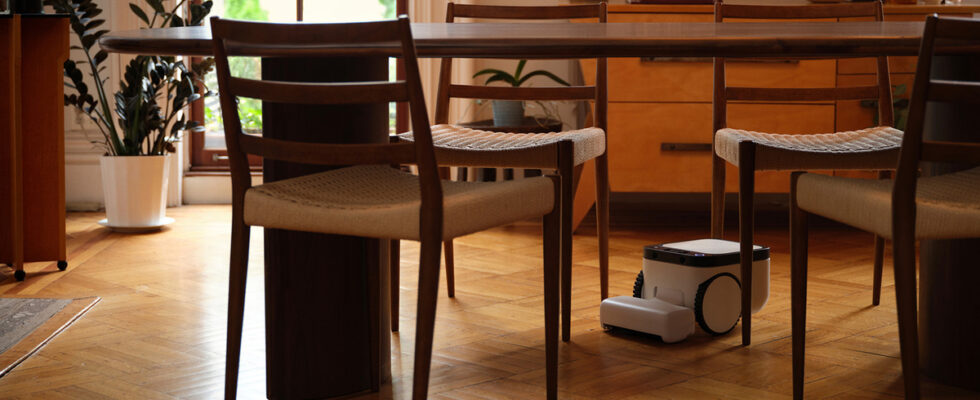robot
In the absence of offers discover
The links shown above may not work if an ad blocker is used.
Roborock, Dreame and even iRobot had better watch out. After cutting their teeth at Google, working in particular on Nest Cams and intelligent detection, two engineers set out to create a robot intelligent enough to vacuum and wash the house without ever getting stuck. And Matic was. Don’t be fooled by its slightly… retro look. This little robot would be a real concentrate of technology.
Two rollers for vacuuming and washing
In any case, Matic does nothing like the others. It doesn’t look like any other either. With its imposing body and its washing head at the front, it is closer to the good old sleds than to the robots we know today. This design allows it to integrate not only brushes almost as wide as itself – rubber for solid waste, and another in microfiber for liquid waste – but also containers of reasonable size. Matic integrates more precisely a 600 ml water tank sufficient to wash, according to its creators, a surface area of 120 m2 and a bag, the capacity of which remains to be specified, but sufficient to contain a week’s worth of waste for one cleaning daily.
Five cameras and a good dose of AI
It should be noted that the bag is supposed to filter fine particles (HEPA) and be able to contain both solid and liquid waste, the latter being “transformed into solid debris to avoid leaks” upon entry, we can read. This is intriguing, but not as much as the navigation system based not on a laser rangefinder as most current high-end robots incorporate, but on a set of cameras. Matic includes 5, just that! They are distributed across the tower and associated with artificial intelligence responsible for analyzing the images to create a map. So far, nothing really extraordinary. But Matic’s maps are in 3D, and we are not talking about 2D maps extrapolated into 3D to add virtual furniture as offered by Roborock, for example. The robot actually scans the house from floor to ceiling and transcribes everything into the control application. All without the slightest laser. One might believe that the 2D images of a simple RGB sensor are too imprecise, but Google veterans have acquired solid experience in their processing. The demonstration videos that can be found on the web are in any case impressive.
We can also see the robot marking the slightest obstacle on the maps, to recalculate its trajectory and avoid it. It even promises to detect dirt littering the floor, in order not only to juggle between vacuuming and washing, but also to ensure that everything is eliminated; he is therefore supposed to pass and return to the same place as long as the ground is not immaculate. To allow Matic to see even in the dark, the cameras have an infrared mode and the robot must also be able to respond to certain gestures, which it is also possible to combine with voice commands since it also carries a mic. You can therefore ask him to clean a specific area by pointing at it. Surfaces are of course also detected, and it is specified that the data collected by the robot is stored and analyzed locally. No risk of seeing one’s intimate life displayed on the web, as was the case for an unfortunate Roomba user…
A compact station, but a robot that is not so compact
Matic’s promises are very good, but we can still raise some “black” points such as the obligation to buy bags, and this quite frequently if they have to be changed every week. While some current robots can also use bags, these are generally housed in their station and can contain waste from several weeks or even months of use. Matic has chosen a compact station. The robot still has the merit of automating the ordering of consumables by “tracking” their use, but it might have been more interesting to offer automatic emptying to reduce the dimensions of the robot.
Although it should not have too much difficulty slipping between chair legs, its almost 20 cm height may prevent it from passing under furniture which would not pose a problem for most robots, even when topped with ‘a laser rangefinder, like a bed or a sofa. The station also does not offer a washing system for the microfiber roller, but it should be rinsed continuously. We could still have expected a water tank or a connection system for a water supply, and we can add that only iOS users are currently targeted. An Android version of the control app is planned, but it shouldn’t arrive until the fall.
This last point should not change much for us, however, since the Matic robot will initially only be offered in the United States. It will be launched there at the recommended retail price of $1,795, the equivalent of approximately €1,650. A substantial price, to which is added a subscription of $180/year for the delivery of bags and other consumables.
